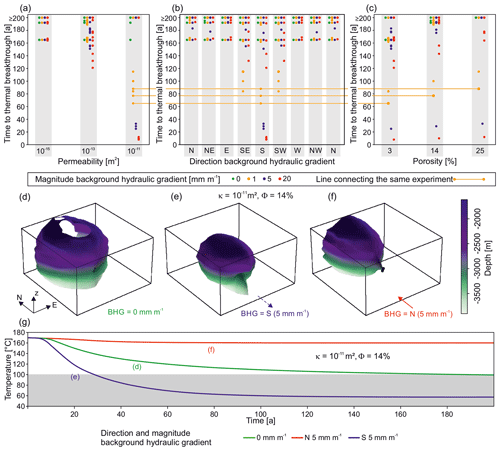A numerical sensitivity study of how permeability, porosity, geological structure, and hydraulic gradient control the lifetime of a geothermal reservoir (Solid Earth)
By Johanna F. Bauer, et al
We show, using over 1000 (n=1027) 4-D finite-element models of a simple geothermal doublet, that the lifetime of a reservoir is a complex function of its geological parameters, their heterogeneity, and the background hydraulic gradient (BHG). In our models, we test the effects of porosity, permeability, and BHG in an isotropic medium. Furthermore, we simulate the effect of permeability contrast and anisotropy induced by layering, fractures, and a fault. We quantify the lifetime of the reservoir by measuring the time to thermal breakthrough, i.e. how many years pass before the temperature of the produced fluid falls below the 100 ∘C threshold.
The results of our sensitivity study attest to the positive effect of high porosity; however, high permeability and BHG can combine to outperform the former. Particular configurations of all the parameters can cause either early thermal breakthrough or extreme longevity of the reservoir. For example, the presence of high-permeability fractures, e.g. in a fault damage zone, can provide initially high yields, but it channels fluid flow and therefore dramatically restricts the exploitable reservoir volume.
We demonstrate that the magnitude and orientation of the background hydraulic gradient (BHG), provided permeability is sufficiently high, are the prime parameters that affect the lifetime of a reservoir. Our numerical experiments show also that BHGs (low and high) can be outperformed by comparatively small variations in permeability contrast (103) and fracture-induced permeability anisotropy (101) that thus strongly affect the performance of geothermal reservoirs.
Read More.........
Bauer, J. F., Krumbholz, M., Luijendijk, E., and Tanner, D. C.: A numerical sensitivity study of how permeability, porosity, geological structure, and hydraulic gradient control the lifetime of a geothermal reservoir, Solid Earth, 10, 2115–2135, https://doi.org/10.5194/se-10-2115-2019, 2019.
